7 Api test example You Should Know
Mastering API testing requires more than just theory; it demands hands-on practice with concrete examples. This guide provides a curated collection of practical, real-world api test example scenarios across various tools and platforms. We will move beyond basic "200 OK" checks to explore the critical edge cases, failure states, and complex validation scenarios that define robust, production-ready applications. Whether you're a developer, QA engineer, or DevOps professional, these examples are designed to be immediately useful and replicable.
This listicle breaks down specific test cases for platforms like Postman, Swagger, and JSONPlaceholder, offering detailed code snippets and strategic analysis. You'll find examples covering everything from data validation and schema adherence to authentication flows and error handling for 4xx/5xx status codes. We focus on demonstrating not just how to write a test, but why a particular approach is effective for ensuring reliability and performance.
Before building tests, a solid understanding of the API's contract is essential. Well-structured documentation is the foundation for effective testing strategies. For a deeper dive into creating clear and testable API contracts, consider these 7 API Documentation Best Practices. Each entry in our list includes screenshots and direct links, so you can jump right into the tools and start experimenting with your own API test example implementation.
1. dotMock
dotMock stands out as a premier cloud-based API mocking platform, meticulously engineered to streamline how development and QA teams approach API testing. It fundamentally eliminates the traditional setup friction associated with mock servers, enabling users to generate and deploy robust, production-like mock APIs in under a minute. This capability is crucial for teams looking to accelerate parallel development and create a comprehensive api test example for any scenario.
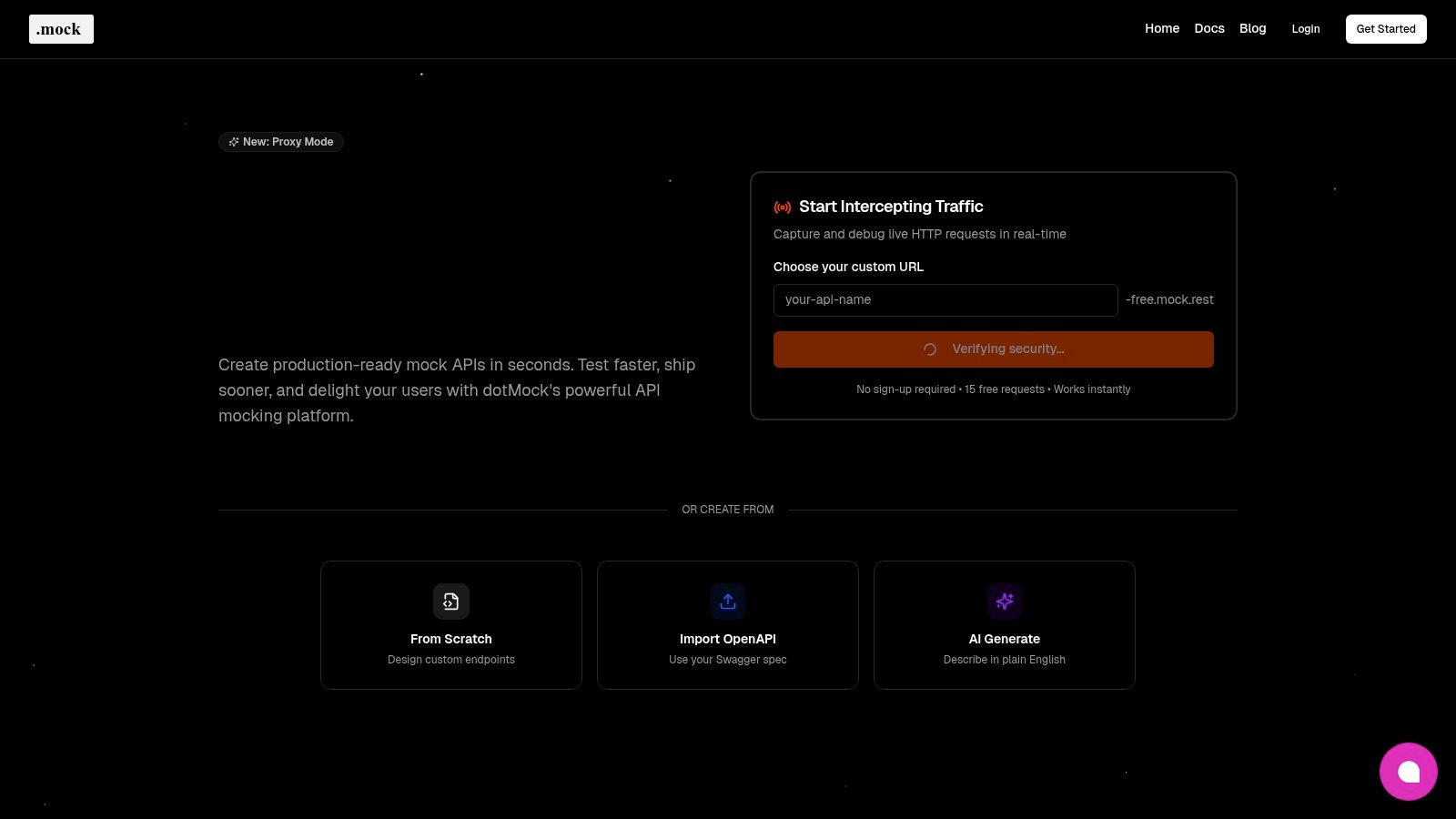
What truly distinguishes dotMock is its powerful and flexible approach to mock creation, moving beyond basic static responses. It caters to a wide array of workflows, ensuring that frontend developers, QA engineers, and SREs have the tools they need to build resilient applications without dependencies on live backend services.
Key Capabilities and Analysis
dotMock's feature set is designed for comprehensive API simulation and testing. Its core strength lies in its advanced fault injection capabilities, which are essential for modern resilience engineering.
Strategic Breakdown:
- Versatile Mock Creation: Users are not locked into a single method. They can intercept live HTTP traffic to replicate real-world behavior, import existing OpenAPI/Swagger specifications for instant API scaffolding, design endpoints from scratch via a user-friendly interface, or even use plain-English AI commands to generate complex mocks.
- Advanced Fault Simulation: This is where dotMock shines for QA and SRE teams. It allows for the precise simulation of various failure scenarios that are otherwise difficult and risky to test against production systems. This includes:
- HTTP
500server errors - Request timeouts and deliberate slow responses
- Network failures and latency injection
- API rate limiting
- HTTP
- Zero-Configuration Cloud Environment: The platform is entirely cloud-based, meaning no local setup, no container management, and no configuration files. This instant-on approach dramatically shortens the time from concept to a usable mock endpoint, a significant advantage for fast-paced agile teams.
Actionable Takeaway: Use dotMock's fault injection to create a dedicated test suite for your application's error-handling logic. For example, configure a mock endpoint to return a
503 Service Unavailableerror or introduce a 5-second delay to verify that your frontend correctly displays a loading state and handles the timeout gracefully.
The platform's approach to API simulation is a practical application of service virtualization, a concept that helps decouple dependencies in complex architectures. To delve deeper into this, you can learn more about the principles of service virtualization on dotmock.com.
Pricing and Access
dotMock offers a transparent, tiered pricing model suitable for individuals and large organizations. A free tier is available for experimentation and small projects, though it comes with usage limits. Paid plans start at an accessible $8/month, unlocking higher request volumes and advanced features for professional use. With a 99.9% uptime SLA, it provides a reliable foundation for critical development and testing workflows.
Website: https://dotmock.com
2. Postman (Public API Network + Templates)
Postman has evolved from a simple API client into a comprehensive platform, and its Public API Network and Template library are exceptional resources for finding hands-on API test examples. Instead of just showing static code, Postman provides fully functional, forkable "collections" of API requests complete with pre-written test scripts. This interactive approach allows developers and QAs to immediately execute and dissect real-world testing scenarios.
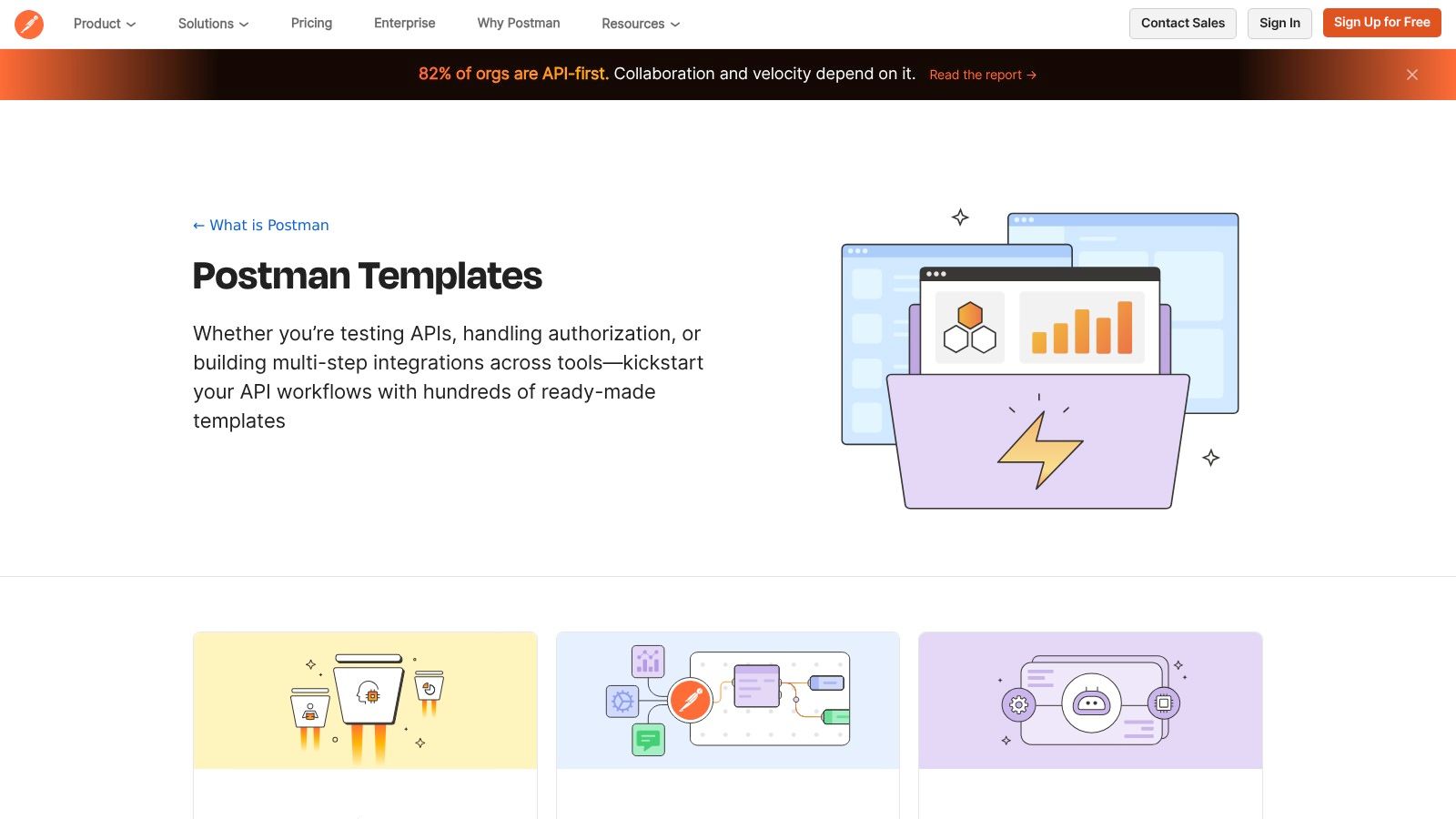
The platform’s strength lies in its low-friction onboarding. Users can find a template for a common use case, like a social media API or a payment gateway, and click the "Run in Postman" button. This instantly imports the entire collection, including authentication setups and environment variables, into their workspace. From there, you can send requests, view responses, and analyze the JavaScript-based test scripts that verify status codes, response times, and JSON schema integrity.
Strategic Analysis & Actionable Insights
What makes Postman's approach unique is its emphasis on immediate execution over passive reading. This is a crucial advantage for teams needing to prototype or learn quickly.
- Tactical Insight: Use the "Fork" feature on a collection to create your own editable copy. This allows you to modify test scripts, add new requests for edge cases, or point the requests to your own API endpoints while preserving the original template.
- Actionable Takeaway: Search for collections that demonstrate complex authentication flows like OAuth 2.0. Forking and running these provides a practical, step-by-step understanding of the token exchange process that is often difficult to grasp from documentation alone.
- Unique Feature: The built-in test scripting uses a Chai.js-like assertion library, making it intuitive for anyone familiar with JavaScript testing frameworks. You can find a complete api test example within these scripts, covering everything from simple status checks to more complex response body validation. For those new to the concepts, exploring how to test REST APIs can provide valuable foundational knowledge.
Platform Details
| Feature | Description |
|---|---|
| Pricing | Free tier available with core features; Paid tiers offer more advanced collaboration and runner options. |
| Accessibility | Requires a free Postman account for the best experience (forking, workspaces). |
| Pros | Low barrier to entry: Fork and run tests in minutes. Rich library: Templates for REST, GraphQL, etc. |
| Cons | Some advanced features are behind a paywall. Dependency on the Postman ecosystem. |
Website: https://www.postman.com/templates/
3. Swagger (OpenAPI) Petstore + Swagger Editor
The Swagger Petstore is a classic, live demonstration API that serves as a practical sandbox for anyone learning about RESTful services and the OpenAPI Specification. Paired with the interactive Swagger UI and Swagger Editor, it provides an invaluable environment for understanding API contracts and executing live test requests directly from the browser. This platform is foundational for grasping contract-first API design, where the API's specification dictates its functionality.

Its primary strength is immediate accessibility. Users can navigate to the Petstore URL and instantly interact with a live API. The Swagger UI automatically generates a browsable documentation page from the OpenAPI specification, complete with a "Try it out" button for every endpoint. This allows developers and QAs to manually send requests, modify parameters, and inspect live responses without writing a single line of code or setting up any local environment.
Strategic Analysis & Actionable Insights
What distinguishes the Swagger Petstore is its role as a universal reference point. It's not just a demo; it’s a teaching tool used across countless tutorials, automated testing tools, and API clients.
- Tactical Insight: Use the Petstore's OpenAPI specification (available as a JSON file) as a source for generating client-side code or server-side stubs. Many tools can ingest this file to bootstrap development, ensuring your application perfectly aligns with the API contract.
- Actionable Takeaway: Experiment with sending invalid data using the "Try it out" feature to observe the API's error handling. For instance, try to
GET /pet/{petId}with a non-integer ID. This is a simple yet effective api test example for understanding how a well-designed API should return 4xx-level error codes and descriptive error messages. - Unique Feature: The integration with Swagger Editor allows you to load the Petstore's OpenAPI spec and modify it. You can define new endpoints, change data models, or add security schemes, providing a hands-on experience with the OpenAPI Specification syntax itself. This is crucial for architects and leads defining new API contracts.
Platform Details
| Feature | Description |
|---|---|
| Pricing | Completely free to use. Both the Petstore demo and the web-based Swagger Editor are open access. |
| Accessibility | No account or setup required. Fully functional within any modern web browser. |
| Pros | Zero-friction: Instantly usable in the browser. Industry standard: A widely recognized "hello world" for APIs. |
| Cons | Demo-only; not suitable for performance testing or production use. Can occasionally exhibit minor quirks. |
Website: https://petstore3.swagger.io/
4. RapidAPI Hub (Marketplace + Testing Playground)
RapidAPI Hub is best known as a massive marketplace where developers can discover and subscribe to thousands of APIs, but it also serves as a powerful in-browser testing playground. Its primary value for finding an api test example comes from its immediate interactivity. For any listed API, developers can configure parameters, send live requests, and inspect responses directly from the browser, all before writing a single line of code.
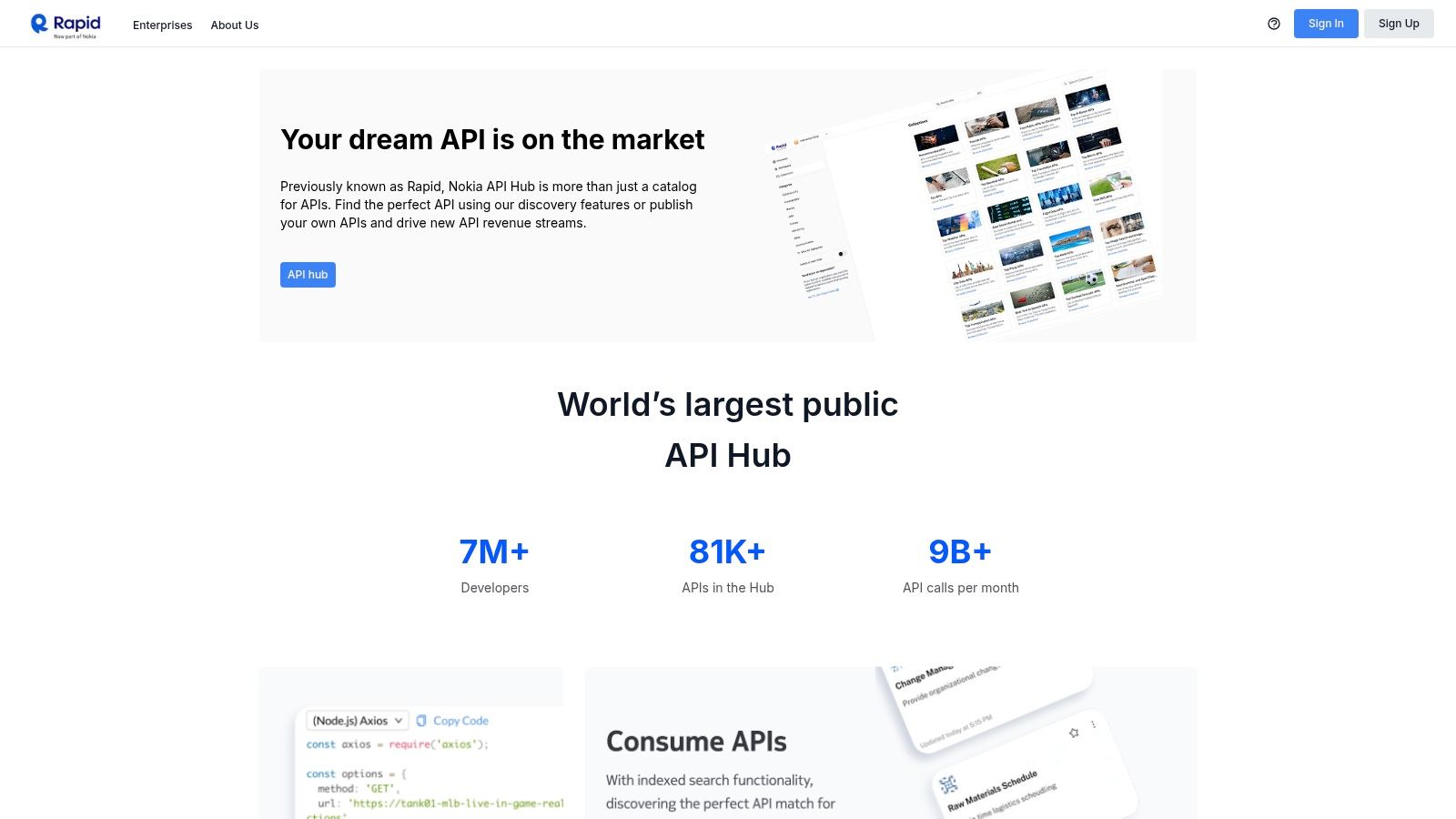
The platform streamlines the initial stages of API integration and testing. After subscribing to an API's free or freemium tier, users are provided with an API key and an interactive interface to test its endpoints. The playground automatically generates code snippets in various languages (like JavaScript, Python, and cURL), which include the necessary headers and authentication tokens. This allows for a seamless transition from manual testing to automated script development.
Strategic Analysis & Actionable Insights
What makes RapidAPI Hub unique is its dual function as both a discovery engine and an immediate validation tool. This combination drastically reduces the time between finding a third-party service and verifying its behavior.
- Tactical Insight: Use the built-in playground to test an API's error handling. Deliberately send requests with invalid parameters, incorrect authentication tokens, or missing required fields to see how the API responds. The immediate feedback is invaluable for building resilient applications.
- Actionable Takeaway: When evaluating multiple APIs for the same purpose (e.g., weather data), use the playground to quickly compare their response structures, data quality, and latency side-by-side. This practical, hands-on evaluation is far more effective than just reading documentation.
- Unique Feature: The platform standardizes the subscription and billing process across a vast number of disparate APIs. This allows teams to manage multiple third-party API keys and usage plans from a single dashboard, simplifying both technical and administrative overhead.
Platform Details
| Feature | Description |
|---|---|
| Pricing | Hub access is free; pricing and quotas vary significantly per individual API provider (free, freemium, paid). |
| Accessibility | Requires a free RapidAPI account to subscribe to APIs and manage API keys for testing. |
| Pros | Centralized discovery: Find and test thousands of APIs in one place. Standardized process: Consistent subscription and billing management. |
| Cons | API quality and documentation can be inconsistent. Pricing models require careful review for each provider. |
Website: https://rapidapi.com/
5. JSONPlaceholder (Free Fake REST API)
JSONPlaceholder is an essential utility for anyone needing a reliable, zero-setup fake REST API for prototyping and testing. It provides a set of common API resources like /posts, /users, and /todos that behave predictably, making it the perfect sandbox for writing and validating API test scripts without the complexity of authentication or a real backend. Its simplicity allows developers and QAs to focus purely on the client-side logic and testing framework implementation.

The platform’s core strength is its immediate accessibility. There is no signup, no API keys, and no rate limiting, which removes all friction. You can start sending GET, POST, PUT, and DELETE requests from your code, a command line tool like cURL, or an API client like Postman, and receive predictable JSON responses instantly. This makes it an invaluable resource for tutorials, live coding demos, and creating a reproducible api test example for bug reports or documentation.
Strategic Analysis & Actionable Insights
What makes JSONPlaceholder so powerful is its role as a "control group" for API tests. By providing a stable and known-good API, you can isolate issues in your own test code or framework setup, confident that the server-side is not the problem.
- Tactical Insight: Use the
/posts/1and/postsendpoints to practice different assertion types. For a single resource, verify specific key-value pairs (userId: 1). For a collection, test the response structure, such as ensuring every object in the array contains atitlekey. - Actionable Takeaway: Simulate a complete CRUD workflow using the API. Send a
POSTto/posts, use the ID from the response to send aPUTorPATCHrequest to update it, and finally, send aDELETErequest. Although the changes won't persist, this workflow is perfect for validating the logic of your test suite. - Unique Feature: The API supports query parameters for filtering, such as
/posts?userId=1. This is ideal for practicing how to construct dynamic requests and write tests that verify the accuracy of filtered data, a common and critical testing scenario. For those looking to go from consumer to creator, it's useful to understand how to make an API with similar functionality.
Platform Details
| Feature | Description |
|---|---|
| Pricing | Completely free to use with no limitations. |
| Accessibility | Publicly accessible online; no account or authentication required. |
| Pros | Zero setup required: Immediately available for requests. Highly reliable: Consistent and stable uptime. |
| Cons | Data is static and writes do not persist. Lacks complex features like authentication or file uploads. |
Website: https://jsonplaceholder.typicode.com/
6. Reqres (Hosted REST API for Front-end Tests)
Reqres provides a real, hosted REST API designed specifically for testing front-end applications and practicing API test automation. Unlike static mock servers that only return hardcoded data, Reqres offers dynamic endpoints for common user actions like creating, listing, updating, and deleting resources. This functionality allows developers and testers to build and validate their API clients against a responsive, predictable backend without any setup.
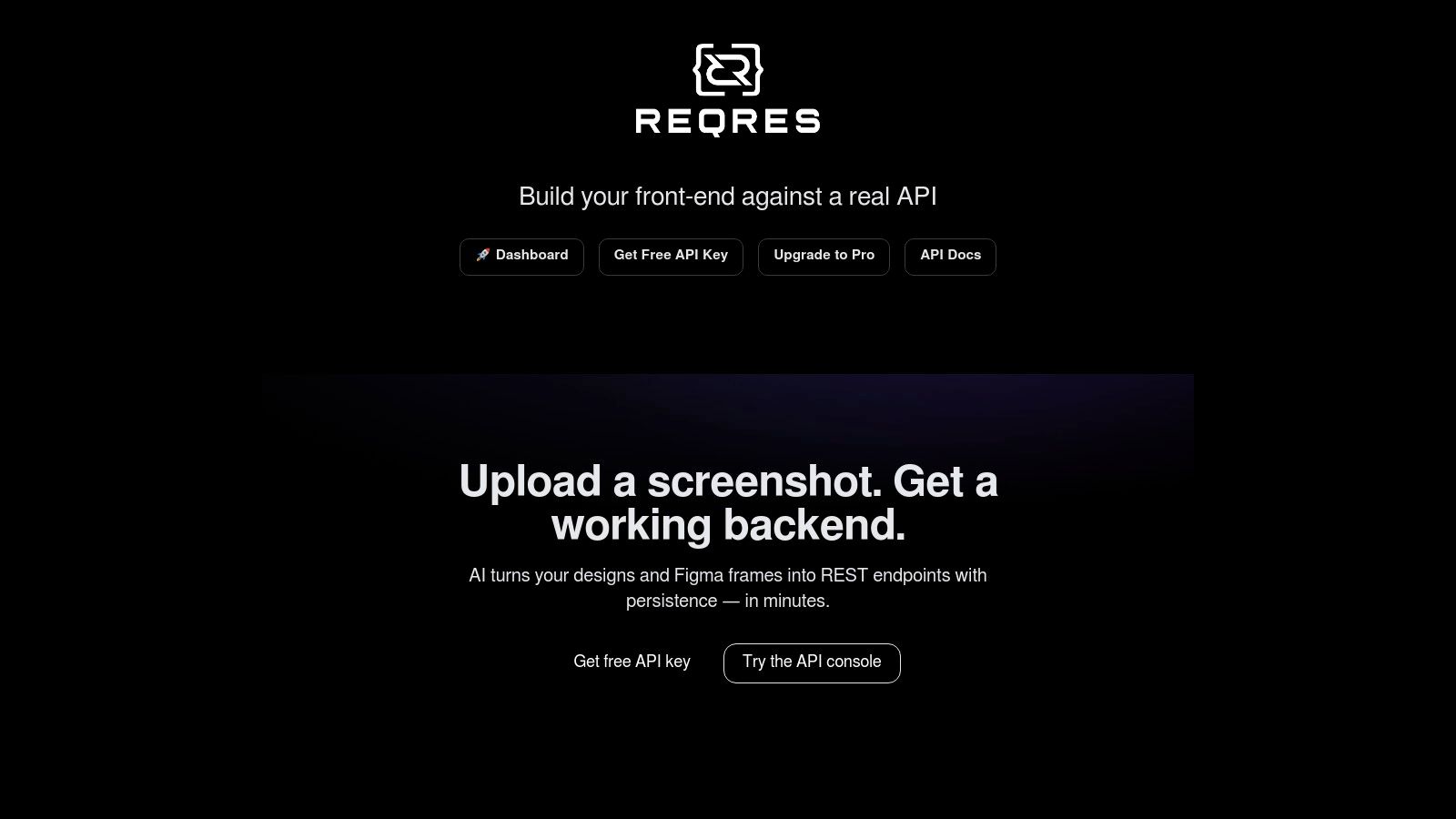
The platform’s key advantage is its focus on simulating both success and failure scenarios out of the box. It includes dedicated endpoints for successful and unsuccessful logins, user not found errors, and even delayed responses to test how an application handles latency. Each endpoint page provides a clear request format and the exact JSON response to expect, making it an excellent resource for writing precise test assertions.
Strategic Analysis & Actionable Insights
Reqres stands out by providing a hassle-free, live environment for validating negative paths and edge cases, which are often overlooked in early development. This makes it an invaluable tool for building resilient applications.
- Tactical Insight: Use the
/api/users?delay=3endpoint to specifically test UI components like loading spinners, skeletons, and timeout logic. This allows you to verify that the user experience remains smooth and informative during network latency, a common real-world problem. - Actionable Takeaway: When building your test suite, write a dedicated api test example for the
/api/registerand/api/loginfailure endpoints. This ensures your application's error handling correctly processes and displays messages for missing passwords or invalid user credentials, improving overall robustness. - Unique Feature: Reqres requires no authentication or setup. You can start hitting its endpoints immediately with any HTTP client (cURL, Postman, Fetch), making it one of the fastest ways to prototype API interactions or teach fundamental API testing concepts.
Platform Details
| Feature | Description |
|---|---|
| Pricing | Completely free to use. It is a hosted service without any paid tiers or required sign-up. |
| Accessibility | Publicly accessible with no authentication required. Anyone can make requests to the API endpoints. |
| Pros | Zero setup: Immediately available for testing. Covers negative paths: Pre-built failure and latency endpoints. |
| Cons | Data is not persistent; it resets. Not suitable for performance or load testing. |
Website: https://reqres.in/
7. HTTPBin (HTTP Request/Response Testing Service)
HTTPBin is a uniquely powerful tool designed for one core purpose: to test how your HTTP client behaves. Unlike services that provide real-world data, HTTPBin offers a diverse set of endpoints that reflect, inspect, and respond to your HTTP requests. This makes it an indispensable resource for crafting API test examples that focus on the underlying mechanics of web communication, from validating custom headers to simulating various failure states like redirects and authentication challenges.
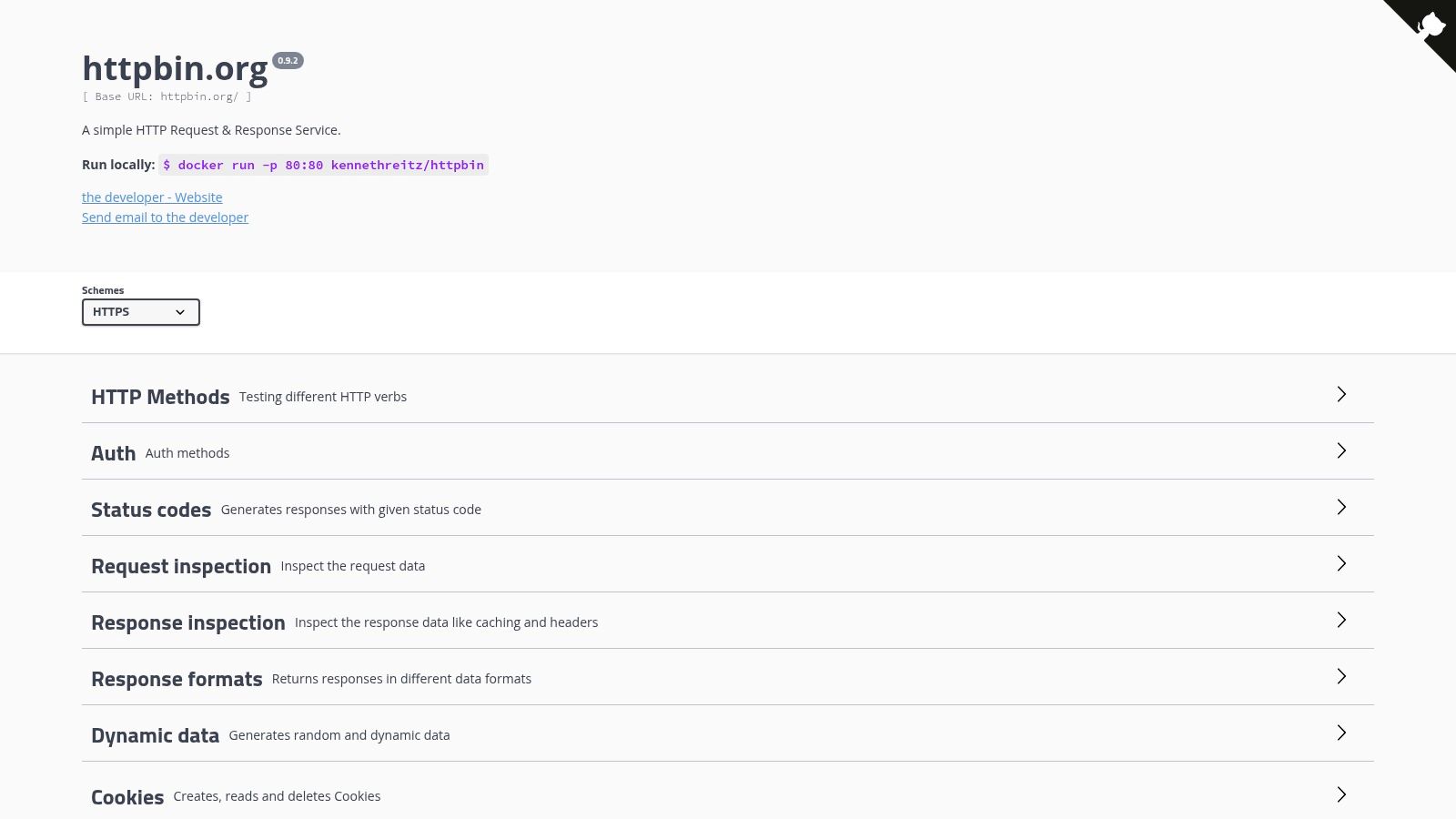
The platform’s strength is its simplicity and directness. There is no signup or setup required; you simply make requests to its endpoints and analyze the predictable responses. For example, a POST request to /post will return a JSON object containing everything you sent, including the headers, form data, and body. This immediate feedback loop is perfect for debugging complex requests or for teaching developers the fundamentals of HTTP.
Strategic Analysis & Actionable Insights
HTTPBin's value lies in its ability to isolate and test specific parts of the HTTP protocol without the noise of a real application's business logic. This allows for precise and reliable unit testing of your API client code.
- Tactical Insight: Use the
/status/{code}endpoint to test how your client handles various HTTP status codes, especially non-200 responses like 401 (Unauthorized), 429 (Too Many Requests), or 503 (Service Unavailable). This is crucial for building resilient error-handling logic. - Actionable Takeaway: When testing a feature that relies on specific request headers (e.g.,
X-Request-IDorAuthorization), use the/headersendpoint. It echoes all headers sent, providing an easy way to assert that your client is constructing them correctly before you test against a live API. - Unique Feature: The
/delay/{n}endpoint is a standout for testing timeouts and latency resilience. An api test example using this can verify that your client's timeout configurations work as expected and that your application gracefully handles slow network responses, a common but difficult-to-replicate production issue.
Platform Details
| Feature | Description |
|---|---|
| Pricing | Completely free to use. |
| Accessibility | Publicly accessible with no signup or API keys required. An official Docker image is available for local hosting. |
| Pros | Extremely versatile: Covers a wide range of HTTP scenarios. Zero setup: Immediately usable for any script or tool. |
| Cons | Public instance may have rate limits or availability issues. Focuses only on HTTP, not data models. |
Website: https://httpbin.org/
API Testing Tools Comparison Matrix
| Platform | Implementation Complexity 🔄 | Resource Requirements ⚡ | Expected Outcomes 📊 | Ideal Use Cases 💡 | Key Advantages ⭐ |
|---|---|---|---|---|---|
| dotMock | Low - zero-configuration, cloud-based | Moderate - cloud hosting, paid tiers for heavy use | Robust, production-ready mock APIs with fault simulation | Parallel frontend/backend development, resilient app testing | Fast setup, advanced fault injection, team collaboration |
| Postman (Public API Network + Templates) | Low - fork templates and immediate use | Low - requires Postman account | Quick API testing and learning via ready-to-run templates | API testing basics, onboarding, demo workflows | Rich templates, scripting, collaborative workspaces |
| Swagger (OpenAPI) Petstore + Editor | Very low - browser-based, no setup | Very low - web app only | Interactive OpenAPI demos and contract-first design learning | API design tutorials, spec experimentation | Widely recognized, interactive, zero setup |
| RapidAPI Hub (Marketplace + Playground) | Medium - subscription & account needed | Medium - varies by API provider | Immediate API testing plus marketplace discovery | API discovery, diverse API testing, CI/CD integration | Centralized marketplace, test playground, automated tests |
| JSONPlaceholder (Free Fake REST API) | Very low - fully public, no signup | Minimal - public REST API | Static fake REST data for prototyping and unit tests | Quick demos, prototyping, educational use | Free, reliable, zero setup |
| Reqres (Hosted REST API for Front-end) | Very low - public REST API | Minimal - free tier with limits | Frontend API testing with login flows, delayed response | Frontend tests, error handling, latency simulation | User management flows, latency/error simulation |
| HTTPBin (HTTP Request/Response Testing) | Very low - public endpoints | Minimal - public or self-hosted | Detailed HTTP request/response inspection and debugging | HTTP client testing, debugging HTTP mechanics | Versatile endpoints, Docker image, no signup |
Final Thoughts
We've journeyed through a diverse landscape of tools and platforms, each offering a unique approach to crafting a robust api test example. From the highly structured environments of Swagger and Postman to the minimalist utility of JSONPlaceholder and HTTPBin, the core lesson is clear: effective API testing is not about finding a single "best" tool, but about assembling the right toolkit for your specific needs.
The examples explored in this guide demonstrate that a comprehensive testing strategy goes far beyond simple 200 OK status checks. It involves simulating real-world conditions, anticipating failure states, and ensuring your application behaves gracefully when dependencies misbehave. Tools like dotMock and HTTPBin are invaluable for this, allowing you to proactively test for timeouts, server errors, and malformed responses without impacting live systems.
Key Takeaways and Strategic Synthesis
Reflecting on the examples, several key principles emerge for building a powerful API testing workflow:
- Start with the Contract: Tools like Swagger and the OpenAPI Specification provide the foundational "source of truth." Building tests directly from your API contract ensures that your implementation never deviates from its design, creating alignment between front-end and back-end teams.
- Embrace Both Mocking and Live Testing: Early-stage development and unit testing thrive on mocked APIs like those from dotMock or JSONPlaceholder, enabling parallel workstreams. As you move toward integration and end-to-end testing, services like Reqres and live endpoints from RapidAPI Hub become essential for validating real-world interactions.
- Test for Failure, Not Just Success: The most resilient systems are those built with failure in mind. A solid
api test examplecollection must include scenarios for 4xx client errors, 5xx server errors, and network issues. Proactively testing these edge cases prevents unexpected user-facing failures in production. - Context is Everything: The right tool depends entirely on your context. A front-end developer building a UI prototype has different needs than a DevOps engineer designing a CI/CD pipeline. Your choice should be driven by factors like team skill set, project complexity, and development stage. For more advanced API testing scenarios, such as those involved in large-scale data scraping or geo-restricted content, understanding how proxies can facilitate testing under various conditions is crucial. Specialized resources on APIs for data scraping can provide deeper insights into managing these complex use cases.
Actionable Next Steps
To translate these insights into practice, consider the following steps:
- Audit Your Current Testing Stack: Evaluate your existing tools. Are you heavily reliant on live endpoints? Is there an opportunity to introduce mocked services to speed up development and isolate components?
- Identify Your Biggest Gaps: Where does your testing process fall short? Are you sufficiently testing for network latency? Do you have a clear strategy for handling third-party API outages?
- Implement One New Example: Choose one
api test examplefrom this article that addresses a key gap and implement it. Start small, perhaps by adding a single negative test case to your existing Postman collection or creating a simple mock endpoint with dotMock for a new feature.
Ultimately, the goal is to build a testing culture where quality is a shared responsibility, enabled by a versatile and intelligent set of tools. By moving beyond basic "happy path" testing and embracing the full spectrum of API behaviors, you empower your team to build more stable, reliable, and resilient applications.
Ready to take control of your API dependencies and accelerate your development cycles? dotMock provides a powerful, intuitive platform to create the exact api test example scenarios you need, from complex success cases to critical failure simulations. Start building more resilient applications today by visiting dotMock.